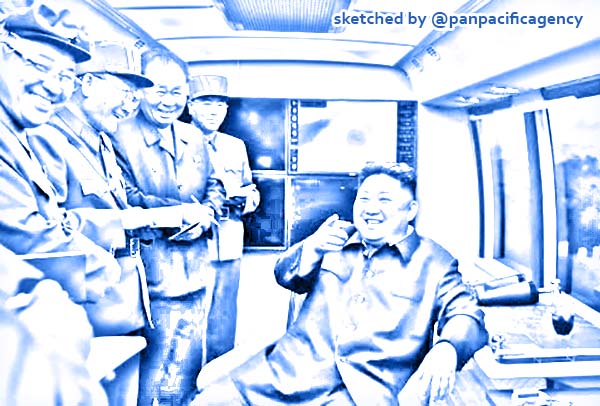[Analytics] How will Kim Jong-un respond to the South Korea-Japan trade dispute?

North Korean leader Kim Jong-un smiles after observing the test launch of a short-range projectile near Hamhung, South Hamgyong Province, on Aug. 10. Sketched by the Pan Pacific Agency.
Many wonder how North Korean leader Kim Jong-un means to respond to the conflict between South Korea and Japan that was provoked by the Abe administration’s export controls on the South. Kim has two options — cooperating with his compatriots in South Korea and standing in solidarity with their government, or treating the dispute as an opportunity to normalize relations with Japan. Lee Jae-hoon specially for the Hankyoreh.
Anti-American and anti-Japanese sentiment and unification represent the very core of North Korea’s national identity. On top of that, North Korea has reiterated to the South at every opportunity that the Korean people should “handle their affairs among themselves” (June 15 Inter-Korean Statement) and preached the “principle that the interest of the Korean people is our top priority and all matters should be subordinated to that” (July 16 edition of the Rodong Sinmun). If the North means what it says, the option of cooperation and solidarity is not so much an option for North Korea as an inevitable path.
That said, such principles are part of the ruling ideology that has mythicized the dynasty of Kim Il-sung, Kim Jong-il, and Kim Jong-un, so they shouldn’t be equated with actual policy. Though the North has always stressed its opposition to Japan, it has sought a way to normalize relations with Japan since the time of Kim Il-sung. Such efforts are tightly linked to the regime’s desperate need to overcome its diplomatic isolation and to lay the material foundation for its economic reconstruction.
Some hints about Kim Jong-un’s choice can be found in the North Korean media. The Rodong Sinmun, as the official organ of the Central Committee of the Workers’ Party of Korea (WPK), is an essential read, while the Korean Central News Agency (KCNA) is the North’s leading outlet for foreign consumption. Day after day, both of these media outlets have been attacking the behavior of the Abe administration and providing detailed coverage of the situation in South Korean society, including the boycott of Japanese products.
N. Korea’s 2-track strategy of criticizing Japan without cooperating with S. Korea
On July 10, the Rodong Sinmun became the first North Korean media outlet to cover the Abe administration’s export controls, thundering that “the Korean people will pay back the evil deeds of our age-old enemy Japan a hundredfold, even a thousandfold.”
North Korea’s analysis of the Abe administration’s motivations was neatly summarized in a July 19 column for the KCNA: “shattering the mood for peace on the Korean Peninsula, creating a political environment that helps them realize their militaristic ambitions, damaging the South Korean economy, paving the way for pro-Japanese traitors to return to power in the South, provoking their masters [i.e., the US] to pay attention to their neglected interests in Korean Peninsula affairs, rallying the right wing, and achieving their long-cherished desire of amending the constitution.” The same column emphasized that “Japan must apologize and provide compensation, and until it does, it will never be given a ticket to Pyongyang.”
Despite the hostile mood toward Japan in North Korea, several other things are worth considering. The North Korean authorities haven’t adopted an official position on the South Korea-Japan conflict, as they might do in an interview with or statement by the spokesperson of the Foreign Ministry. Nor has the North Korean government offered any help to South Korea. In brief, Kim’s initial role in the South Korea-Japan conflict is closer to that of a pundit than a player. That reflects Kim’s signature two-track strategy of harshly criticizing the Abe administration’s actions without pursuing cooperation with the South Korean government.
“Though North Korea is vociferously attacking Japan in the Rodong Sinmun and elsewhere, it could still arrange a summit with Japan when the time is right,” said a former senior official in the South Korean government who is adept at interpreting events in North Korea. This official added, however, that “there’s no possibility of anything happening between North Korea and Japan in the short term.” Since Kim is throwing all his diplomatic resources into quickly arranging a third summit with the US, he can’t afford to turn his attention elsewhere.
N. Korea-Japan relations heavily reliant on N. Korea-US relations
Nor should we ignore the lesson of history, which shows that attempts to improve North Korea-Japan relations are unlikely to bear fruit without progress in North Korea-US relations because of geopolitical dynamics in Northeast Asia.
North Korea and Japan have attempted to normalize diplomatic relations before, notably through a joint statement by the WKP, Japan’s Liberal Democratic Party, and the Japan Socialist Party on Sept. 28, 1990, and through the adoption of the Pyongyang Declaration on Sept. 17, 2002, following the first ever North Korea-Japan summit between Kim Jong-il and former Japanese Prime Minister Junichi Koizumi. But those attempts were frustrated by the first and second nuclear crises in North Korea. That’s why an official at Japan’s Ministry of Foreign Affairs at the time complained, “It seems as if the US moves to block anything we do.”
Under Kim Jong-un’s rule, the two countries tried once again to normalize relations with the Stockholm Agreement, reached on May 29, 2014, which would have traded a new investigation of the abduction issue for partial sanctions relief. But sure enough, this was blocked by an escalation of the North Korea-US conflict. Abe, who often calls for tougher sanctions on North Korea, shelved his demand for talks on the abduction issue when he proposed an “unconditional” meeting with Kim in an interview with the Sankei Shimbun newspaper on May 2, but Kim hasn’t responded.
By Lee Jae-hoon, senior staff writer